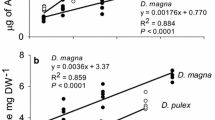Abstract
Freshwater zooplankton species differ in their consumption of live and dead algal cells when tested in situ. Using isotopically-labeled living and heat-killed Chlamydomonas reinhardti as models for phytoplankton and detrital seston, respectively, we tested differential feeding on these foods by 3 rotifers and 2 microcrustaceans. Keratella cochlearis selectively feeds on ‘detrital’ materials while 2 sympatric rotifer species, Conochilus dossuarius and Kellicottia bostoniensis show no ability to discriminate between the living and dead foods. Both the copepod Diaptomus spatulocrenatus and a cladoceran, Bosmina sp., differentially consume living cells.
Similar content being viewed by others
References
Bogdan, K. G., Gilbert, J. J. & Starkweather, P. L. 1980. In situ clearance rates of planktonic rotifers. In this volume, pp. 73–77.
Dumont, H. J. 1977. Biotic factors in the population dynamics of rotifers. Arch. Hydrobiol. Beih. 8: 98–122.
Edmondson, W. T. 1957. Trophic relations of the zooplankton. Trans. Am. microsc. Soc. 76: 225–245.
Erman, L. A. 1962. On the utilization of the reservoirs trophic resources by plankton rotifers. [in Russian]. Byull. Mosk. Obshch. Ispyt. Prir. 67: 32–47.
Gilbert, J. J. & Williamson, C. E. 1978. Predator-prey behavior and its effect on rotifer survival in associations of Mesocyclops edax, Asplanchna girodi, Polyarthra vulgaris, and Keratella cochlearis. Oecologia 37: 13–22.
Haney, J. F. 1971. An in situ method for the measurement of zooplankton grazing rates. Limnol. Oceanogr. 16: 970–977.
Naumann, E. 1923. Specielle Untersuchungen über die Ernährungsbiologie des tierischen Limnoplanktons. 11. Über den Nahrungsbiologie und die natürliche Nahrung der Copepoden und der Rotiferan des Limnoplanktons. Lunds Univ. Arsskr. N. F. 2, 19: 1–17.
Nauwerck, A. 1963. Die Beziehungen zwischen Zooplankton und Phytoplankton im See Erken. Symb. Bot. Upsal. 17: 1–163.
Pourriot, R. 1965. Recherches sur l'écologie des rotifères. Vie Milieu, Suppl. 21: 1–224.
Pourriot, R., 1977. Food and feeding habits of Rotifera. Arch. Hydrobiol. Beih. 8: 243–260.
Starkweather, P. L. 1980. Aspects of the feeding behavior and trophic ecology of suspension-feeding rotifers. In this volume, pp. 63–72.
Starr, R. C. 1978. The culture collection of algae at the University of Texas at Austin. J. Phycol. 14 Suppl: 47–100.
Spittler, P. 1969. Zucht- und Fütterungsversuche an einigen Rädertierarten der Hiddenseer Gewässer. Limnologica 7: 207–211.
Author information
Authors and Affiliations
Rights and permissions
About this article
Cite this article
Starkweather, P.L., Bogdan, K.G. Detrital feeding in natural zooplankton communities: Discrimination between live and dead algal foods. Hydrobiologia 73, 83–85 (1980). https://doi.org/10.1007/BF00019430
Issue Date:
DOI: https://doi.org/10.1007/BF00019430




